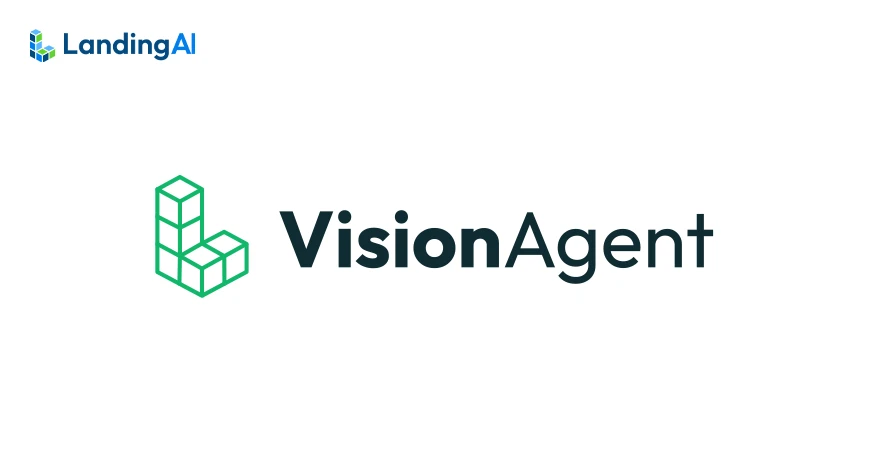
| Model | Recall | Precision | F1 Score |
| Landing AI | 77.0% | 82.6% | 79.7% (highest) |
| Microsoft Florence-2 | 43.4% | 36.6% | 39.7% |
| Google OWLv2 | 81.0% | 29.5% | 43.2% |
| Alibaba Qwen2.5-VL-7B-Instruct | 26.0% | 54.0% | 35.1% |
4. Key Takeaways
- Landing AI’s Agentic Object Detection achieved the highest F1 Score (79.7%), meaning it balances precision and recall better than the others.
- Google OWLv2 had the highest recall (81.0%), meaning it detects the most objects but has lower precision.
- Alibaba’s Qwen2.5-VL-7B-Instruct had relatively low recall but moderate precision.
- Microsoft Florence-2 showed lower performance across all metrics compared to the other models.
Landing AI’s approach seems to provide the most balanced and effective performance in object detection tasks, as reflected in its highest F1 score. The other models have trade-offs, with some excelling in recall but lacking in precision, or vice versa.
Practical Working of VisionAgent
VisionAgent follows a structured process to provide outputs effectively:
- Upload an image you want to analyze
- Write a prompt (e.g., “detect people with glasses”)
- Our AI agent analyzes the image thoroughly
- Receive detection results on your image
1. Prompt: “Detect vegetables in and around the basket”
Step 1: Conversation
A user initiates a request, describing the vision task in natural language. VisionAgent interprets this prompt and confirms the task.
Input Image
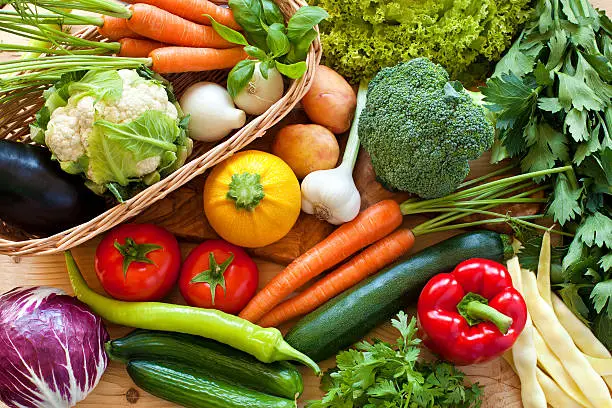
Conversation
“I’ll help you write code to detect vegetables in and around the basket in the image. I’ll use object detection to identify various vegetables in the scene.”
Step 2: Planner
I need to first understand what’s in the image and get suggestions on how to detect vegetables in and around the basket. I’ll start by loading the image and using claude35_vqa and suggestion functions.
Planning Steps
- Understand the image contents using VQA (Visual Question Answering).
- Generate relevant suggestions for the best detection approach.
- Select tools that suit the task, such as object detection and color-based classification.
Example Plan
- Identify all objects in the image.
- Determine which objects are vegetables.
- Differentiate vegetables inside and outside the basket.
- Use a nested detection structure to analyze the spatial relationships.
Execution:
image = load_image('vegetablebasket.jpg')
claude35_vqa('Can you describe this image? What vegetables do you see in and around the basket?', [image])
suggestion('How can I detect vegetables in and around the basket in this image?', [image])Observation
[claude35_vqa output]
This image shows a beautiful array of fresh vegetables arranged around and in a wicker basket. The vegetables include:
1. Fresh carrots with green tops
2. Cauliflower
3. Onions
4. Potatoes
5. Broccoli
6. Eggplant
7. Red tomatoes
8. Yellow squash/zucchini
9. Purple cabbage
10. Green bell pepper
11. Red bell pepper
12. Cucumbers
13. Fresh garlic
14. Fresh herbs (appears to be parsley)
15. Green banana peppers or chili peppers
The vegetables appear to be very fresh and vibrant in color, arranged on what looks like a wooden surface or cutting board. The composition shows a nice variety of colors, from deep purples to bright reds, oranges, and greens, making it visually appealing and suggesting a healthy, nutritious selection of produce.
[end of claude35_vqa output]
[suggestions]
1. The vegetables are both in and around a basket, so relative_position would help in determining their locations with respect to the basket as an anchor point.
2. nested_structure applies because some vegetables are nested/contained within the basket while others are arranged outside it.
3. color would be useful since the vegetables are distinctly colored (red tomatoes, orange carrots, green broccoli, purple cabbage, etc.), making color a key identifier.
4. The problem does not involve small text, grid patterns, tracking in video, comparing sizes specifically, or dealing with extremely small objects in a large image. The depth position is visible but not crucial to the detection task.
[suggestion 0]
You need to find the color of objects in the image, you can use the following code to help with this task:
import numpy as np
import cv2
color_ranges = {
"red_lower": ((0, 100, 100), (int(179 * 20 / 360), 255, 255)),
"orange": ((int(179 * 21 / 360), 100, 100), (int(179 * 50 / 360), 255, 255)),
"yellow": ((int(179 * 51 / 360), 100, 100), (int(179 * 70 / 360), 255, 255)),
"green": ((int(179 * 71 / 360), 100, 100), (int(179 * 150 / 360), 255, 255)),
"cyan": ((int(179 * 151 / 360), 100, 100), (int(179 * 180 / 360), 255, 255)),
"blue": ((int(179 * 181 / 360), 100, 100), (int(179 * 265 / 360), 255, 255)),
"purple": ((int(179 * 266 / 360), 100, 100), (int(179 * 290 / 360), 255, 255)),
"pink": ((int(179 * 291 / 360), 100, 100), (int(179 * 330 / 360), 255, 255)),
"red_upper": ((int(179 * 331 / 360), 100, 100), (179, 255, 255)),
"white": ((0, 0, 200), (179, 25, 255)),
"gray": ((0, 0, 50), (179, 50, 200)),
"black": ((0, 0, 0), (179, 255, 30)),
}
def get_color(image, color_ranges):
hsv_image = cv2.cvtColor(image, cv2.COLOR_RGB2HSV)
detected_colors = {}
for color, (lower, upper) in color_ranges.items():
upper_range = np.array(upper, dtype=np.uint8)
lower_range = np.array(lower, dtype=np.uint8)
mask = cv2.inRange(hsv_image, lower_range, upper_range)
detected_pixels = cv2.countNonZero(mask)
detected_colors[color] = detected_pixels
if "red_lower" in detected_colors and "red_upper" in detected_colors:
detected_colors["red"] = detected_colors["red_lower"] + detected_colors["red_upper"]
del detected_colors["red_lower"]
del detected_colors["red_upper"]
return sorted(detected_colors, key=detected_colors.get, reverse=True)[0]
[end of suggestion 0]
[suggestion 1]
You are trying to count objects within objects, or a nested structure. You can solve this by first detecting the outer objects, then cropping the image to the bounding box of each outer object and detecting the inner objects. You can use the following code to help with this task:
all_dets = ("object", image)
height, width = image.shape[:2]
def area(box):
return (box[2] - box[0]) * (box[3] - box[1])
# only check inner detections on top 25 largest outer detections
largest_dets = sorted(dets, key=lambda x: area(x["bbox"]), reverse=True)[:25]
for det in largest_dets:
x1 = int(det["bbox"][0] * width)
y1 = int(det["bbox"][1] * height)
x2 = int(det["bbox"][2] * width)
y2 = int(det["bbox"][3] * height)
crop = image[y1:y2, x1:x2]
crop_height, crop_width = crop.shape[:2]
inner_dets = ("object", crop)
for inner_det in inner_dets:
x1_inner = int(inner_det["bbox"][0] * crop_width)
y1_inner = int(inner_det["bbox"][1] * crop_height)
x2_inner = int(inner_det["bbox"][2] * crop_width)
y2_inner = int(inner_det["bbox"][3] * crop_height)
bbox = [
x1 + x1_inner,
y1 + y1_inner,
x1 + x2_inner,
y1 + y2_inner,
]
norm_bbox = [
bbox[0] / width,
bbox[1] / height,
bbox[2] / width,
bbox[3] / height,
]
all_dets.append(
{
"label": inner_det["label"],
"score": inner_det["score"],
"bbox": norm_bbox,
}
)
[end of suggestion 1]
[suggestion 2]
You are trying to locate an objects relative to 'anchor' objects. The 'anchor' objects can be detected fine, but there are many of the other objects and you only want to return the ones that are located relative to the 'anchor' objects as specified by the user. You can use the following code to help with this task:
# First find a model that can detect the location of the anchor objects
anchor_dets = ("anchor object", image)
# Then find a model that can detect the location of the relative objects
relative_dets = ("relative object", image)
# This will give you relative objects 'above' the anchor objects since it's the
# distance between the lower left corner of the relative object and the upper left
# corner of the anchor object. The remaining functions can be used to get the other
# relative positions.
def above_distance(box1, box2):
return (box1["bbox"][0] - box2["bbox"][0]) ** 2 + (
box1["bbox"][3] - box2["bbox"][1]
) ** 2
def below_distance(box1, box2):
return (box1["bbox"][0] - box2["bbox"][0]) ** 2 + (
box1["bbox"][1] - box2["bbox"][3]
) ** 2
def right_distance(box1, box2):
return (box1["bbox"][0] - box2["bbox"][2]) ** 2 + (
box1["bbox"][1] - box2["bbox"][1]
) ** 2
def left_distance(box1, box2):
return (box1["bbox"][2] - box2["bbox"][0]) ** 2 + (
box1["bbox"][1] - box2["bbox"][1]
) ** 2
closest_boxes = []
for anchor_det in anchor_dets:
# You can use any of the above functions to get the relative position
distances = [
(relative_det, above_distance(relative_det, anchor_det))
for relative_det in relative_dets
]
# You must grab the nearest object for each of the anchors. This line will give
# you the box directly above the anchor box (or below, left, right depending on
# the function used)
closest_box = min(distances, key=lambda x: x[1])[0]
closest_boxes.append(closest_box)
[end of suggestion 2]
[end of suggestions]
9 Step 3: Execution
The planned steps are executed using the VisionAgent Library and Tools Library. This involves loading the image, running models, and generating detection outputs.
Planner
Based on Claude’s description and the suggestions, I need to detect vegetables both in and around the basket. This is a nested structure problem where I first need to detect the basket and then detect vegetables in relation to it. Let me first get a tool that can detect both the basket and vegetables.
Example Execution Code
image = load_image('vegetablebasket.jpg')
claude35_vqa('Can you describe this image? What vegetables do you see in and around the basket?', [image])
suggestion('How can I detect vegetables in and around the basket in this image?', [image])
get_tool_for_task('Detect basket and vegetables in the image', [image])Observation and Final Output
After execution, VisionAgent produces structured results:
- Detected vegetables categorized inside and outside the basket.
- Bounding box coordinates for each detected vegetable.
- A deployable AI model that can be used for real-world applications.
Output
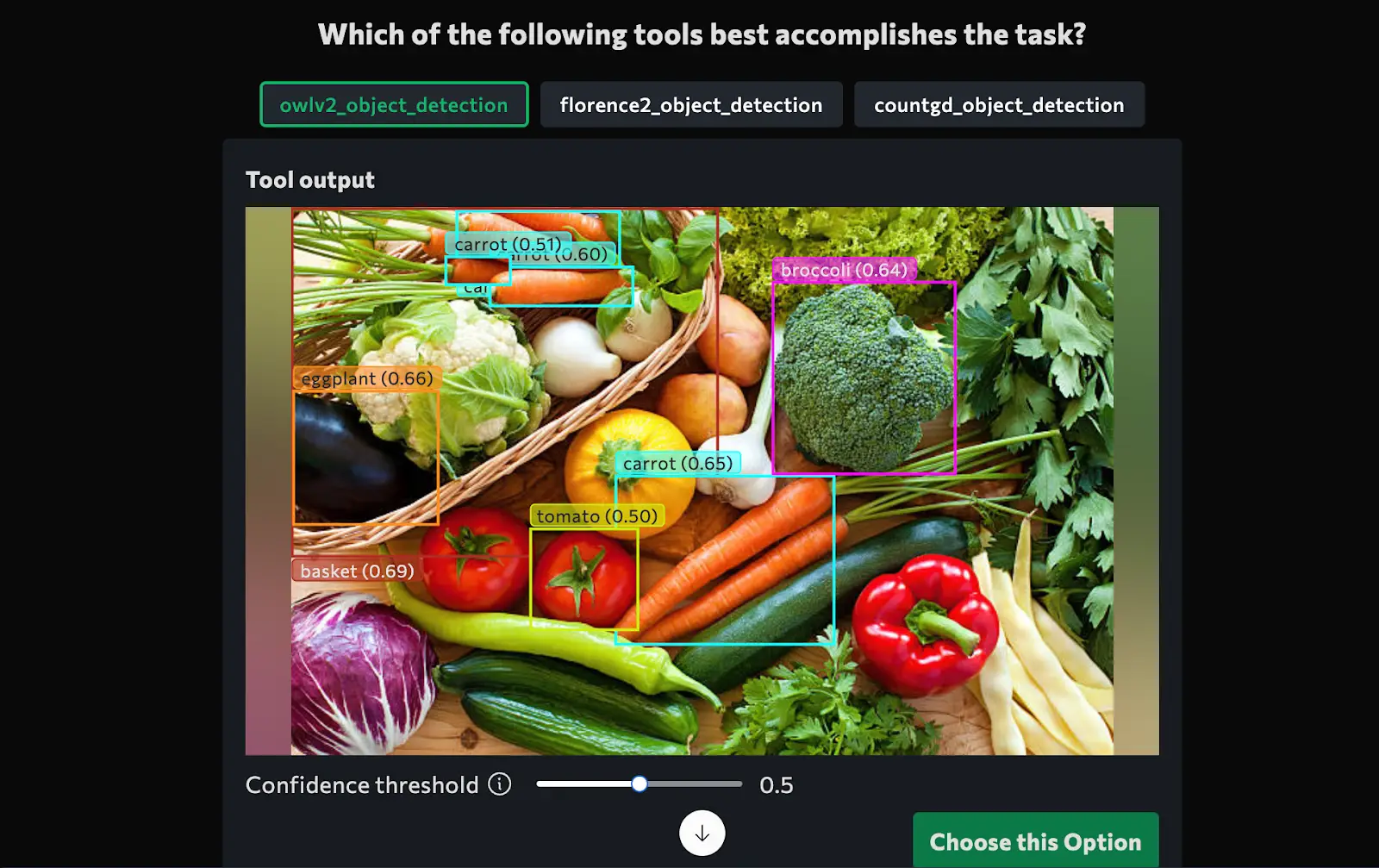
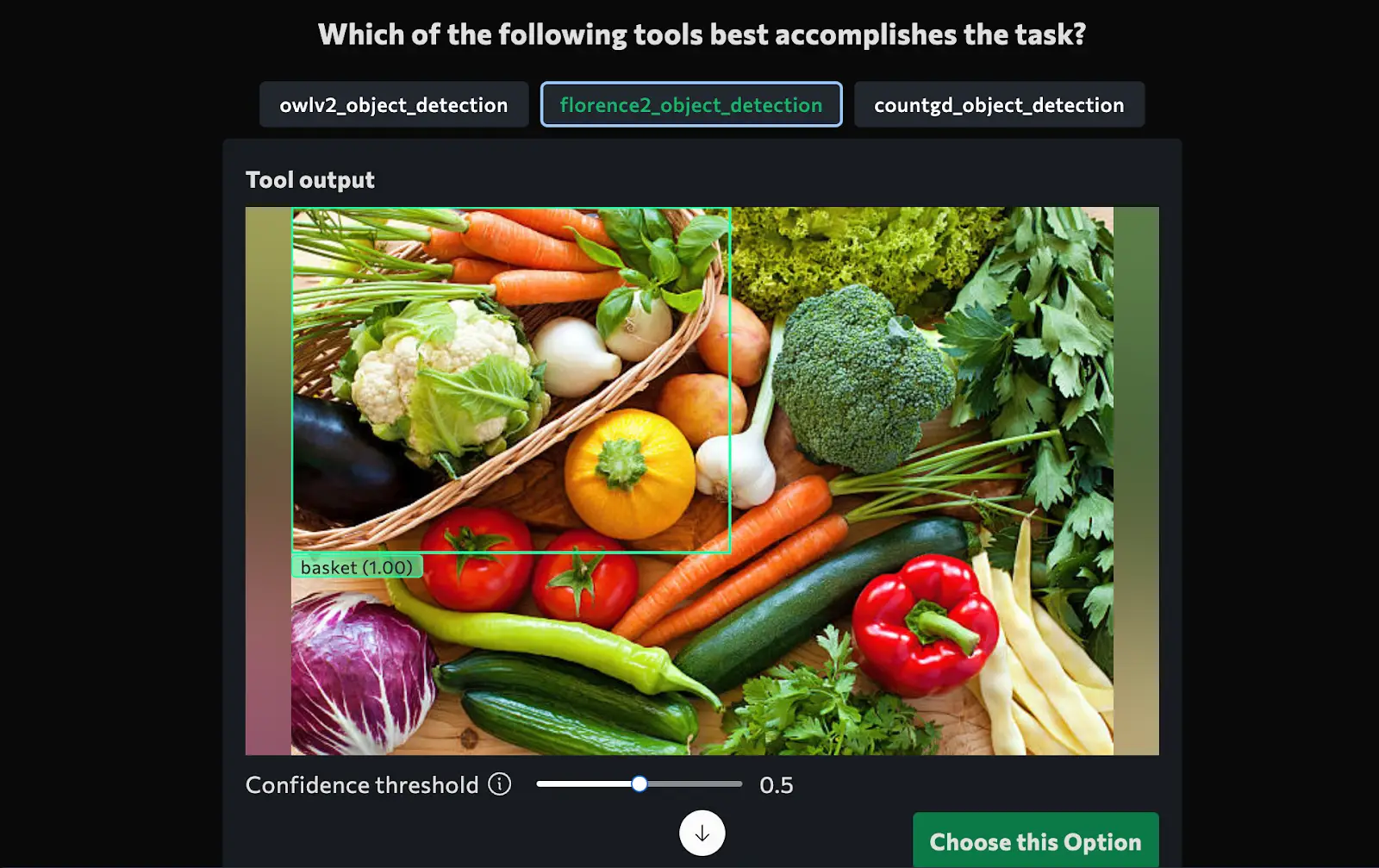
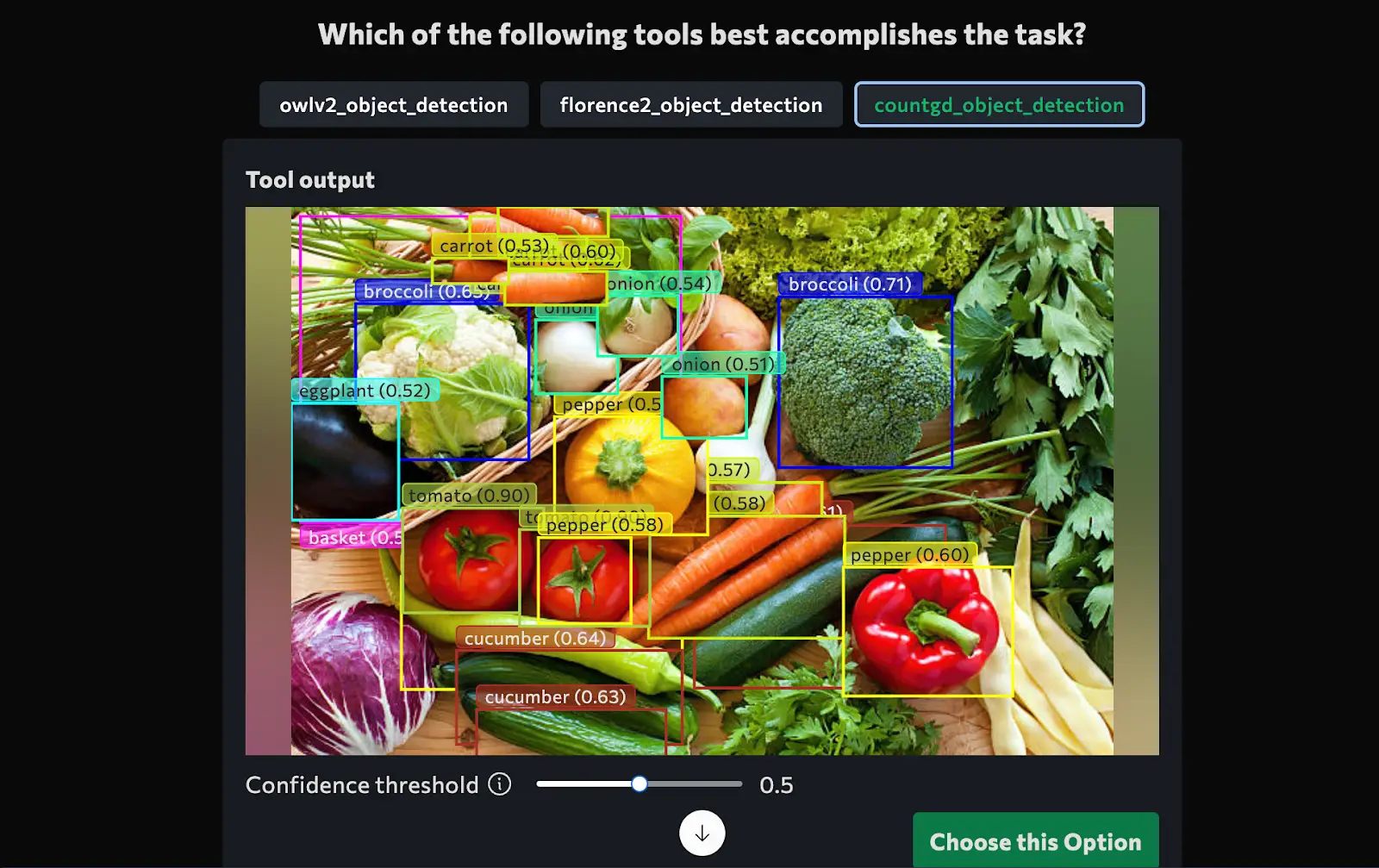
2. Prompt: “Identify red car in the video”
Input Video: Video Link
Step 1: Conversation
I’ll help you write code to identify and track red cars in the video. I’ll use object detection and color-based filtering to accomplish this task.
Step 2: Planner
I need to first understand what’s in the video and get suggestions on how to identify a red car. I’ll extract some frames and use claude35_vqa to describe the video content, then get suggestions.
Step 3: Execution
frames = extract_frames_and_timestamps('videoplayback(4).mp4', 1)
frames = [f["frame"] for f in frames]
claude35_vqa('Can you describe this video? Is there a red car in it?', frames[:5])
suggestion('How can I identify the red car in the video?', frames[:5])Observation
[claude35_vqa output]
Yes, there is a red car (#21) in this video sequence, which appears to be a NASCAR race clip showing an incident between two cars - a red #21 car and a black/gold #3 car with Winchester branding. The video shows them making contact around turn 4 of the track, with the cars getting close to each other and potentially trading paint. The sequence is labeled as "Josh Berry vs Austin Dillon" and shows what appears to be a tense racing moment between the two drivers. The text overlays indicate "WOAH TURN 4", "CONTACT", "BERRY", "A LOT", and "THERE" as the sequence progresses.
[end of claude35_vqa output]
[suggestions]
Based on the user's request to identify the red car in the video and the provided video frames, this is primarily a case of:
1. finding_features_with_video_tracking - The sequence shows a NASCAR race interaction between two cars (Josh Berry and Austin Dillon) where tracking the red #21 car through the turn and contact is key
2. color - The specific request mentions identifying the "red car", making color identification relevant
3. relative_position - The interaction between the two cars requires understanding their positions relative to each other through the turn and contact
The other categories don't apply because:
- This isn't about small text or large images
- There are no grid patterns or missing elements
- This isn't about comparing sizes or nested structures
- While there is some depth perception in racing, the request isn't specifically about determining depth position
[suggestion 0]
You need to find the color of objects in the image, you can use the following code to help with this task:
import numpy as np
import cv2
color_ranges = {
"red_lower": ((0, 100, 100), (int(179 * 20 / 360), 255, 255)),
"orange": ((int(179 * 21 / 360), 100, 100), (int(179 * 50 / 360), 255, 255)),
"yellow": ((int(179 * 51 / 360), 100, 100), (int(179 * 70 / 360), 255, 255)),
"green": ((int(179 * 71 / 360), 100, 100), (int(179 * 150 / 360), 255, 255)),
"cyan": ((int(179 * 151 / 360), 100, 100), (int(179 * 180 / 360), 255, 255)),
"blue": ((int(179 * 181 / 360), 100, 100), (int(179 * 265 / 360), 255, 255)),
"purple": ((int(179 * 266 / 360), 100, 100), (int(179 * 290 / 360), 255, 255)),
"pink": ((int(179 * 291 / 360), 100, 100), (int(179 * 330 / 360), 255, 255)),
"red_upper": ((int(179 * 331 / 360), 100, 100), (179, 255, 255)),
"white": ((0, 0, 200), (179, 25, 255)),
"gray": ((0, 0, 50), (179, 50, 200)),
"black": ((0, 0, 0), (179, 255, 30)),
}
def get_color(image, color_ranges):
hsv_image = cv2.cvtColor(image, cv2.COLOR_RGB2HSV)
detected_colors = {}
for color, (lower, upper) in color_ranges.items():
upper_range = np.array(upper, dtype=np.uint8)
lower_range = np.array(lower, dtype=np.uint8)
mask = cv2.inRange(hsv_image, lower_range, upper_range)
detected_pixels = cv2.countNonZero(mask)
detected_colors[color] = detected_pixels
if "red_lower" in detected_colors and "red_upper" in detected_colors:
detected_colors["red"] = detected_colors["red_lower"] + detected_colors["red_upper"]
del detected_colors["red_lower"]
del detected_colors["red_upper"]
return sorted(detected_colors, key=detected_colors.get, reverse=True)[0]
[end of suggestion 0]
[suggestion 1]
First try to solve the problem using a VQA tool before using the tracking approach for a faster and easier solution:
answer = ("", image)
If that does not work, you can track the objects in the video and then identify features on those objects. You need to first get a tool that can track objects in a video, and then for each object find another tool to identify the features on the object. You can use the following code to help with this task:
track_predictions = Planner
Based on Claude’s description and the suggestions, I need to track cars in the video and identify the red one. Let me first get a tool for tracking cars in the video.
Execution
get_tool_for_task('Track cars in a NASCAR race video', frames[:5])Output
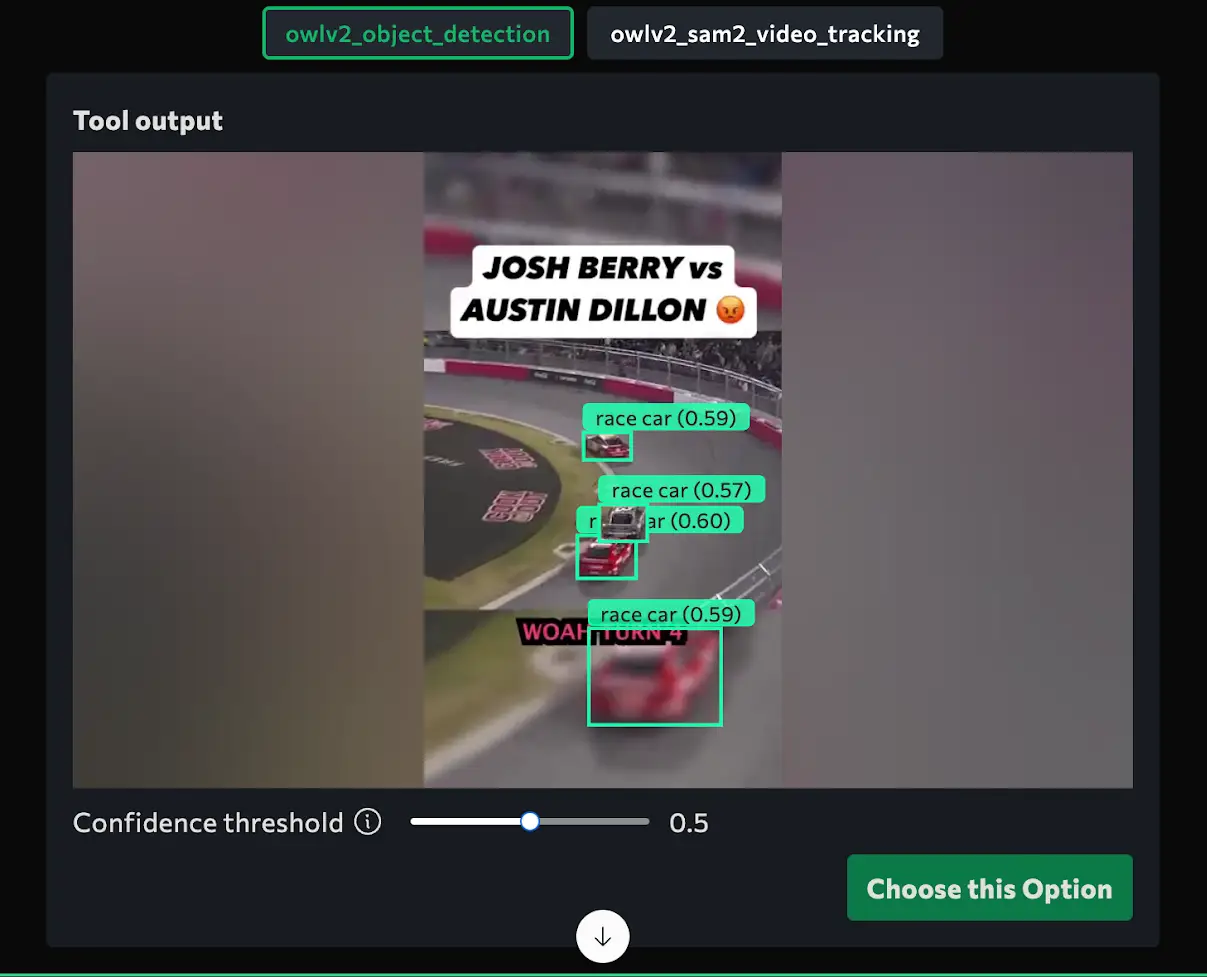
Conclusion
VisionAgent is transforming the way developers build, test, and deploy AI-driven vision applications. By automating tedious processes and providing ready-to-use tools, it significantly reduces development time while ensuring high-quality results. Whether you are an AI researcher, a developer, or a business looking to implement computer vision solutions, VisionAgent provides a fast, flexible, and scalable way to achieve your goals.
With ongoing advancements in AI, VisionAgent is expected to evolve further, incorporating even more powerful models and expanding its ecosystem to support a wider range of applications. Now is the perfect time to explore how VisionAgent can enhance your AI-driven vision projects.

